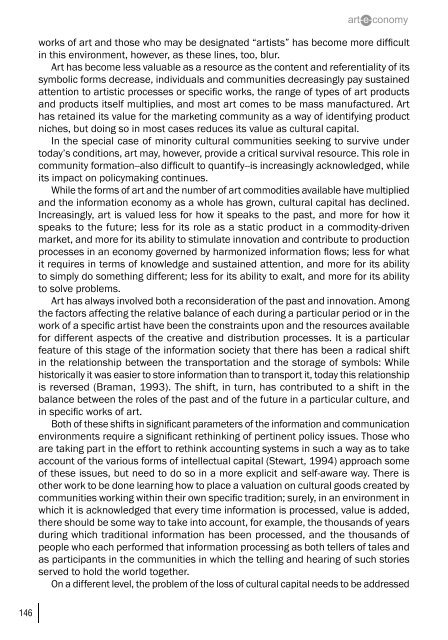art-e-conomy _ reader - marko stamenkovic
art-e-conomy _ reader - marko stamenkovic
art-e-conomy _ reader - marko stamenkovic
You also want an ePaper? Increase the reach of your titles
YUMPU automatically turns print PDFs into web optimized ePapers that Google loves.
146<br />
works of <strong>art</strong> and those who may be designated “<strong>art</strong>ists” has become more difficult<br />
in this environment, however, as these lines, too, blur.<br />
Art has become less valuable as a resource as the content and referentiality of its<br />
symbolic forms decrease, individuals and communities decreasingly pay sustained<br />
attention to <strong>art</strong>istic processes or specific works, the range of types of <strong>art</strong> products<br />
and products itself multiplies, and most <strong>art</strong> comes to be mass manufactured. Art<br />
has retained its value for the marketing community as a way of identifying product<br />
niches, but doing so in most cases reduces its value as cultural capital.<br />
In the special case of minority cultural communities seeking to survive under<br />
today’s conditions, <strong>art</strong> may, however, provide a critical survival resource. This role in<br />
community formation--also difficult to quantify--is increasingly acknowledged, while<br />
its impact on policymaking continues.<br />
While the forms of <strong>art</strong> and the number of <strong>art</strong> commodities available have multiplied<br />
and the information e<strong>conomy</strong> as a whole has grown, cultural capital has declined.<br />
Increasingly, <strong>art</strong> is valued less for how it speaks to the past, and more for how it<br />
speaks to the future; less for its role as a static product in a commodity-driven<br />
market, and more for its ability to stimulate innovation and contribute to production<br />
processes in an e<strong>conomy</strong> governed by harmonized information flows; less for what<br />
it requires in terms of knowledge and sustained attention, and more for its ability<br />
to simply do something different; less for its ability to exalt, and more for its ability<br />
to solve problems.<br />
Art has always involved both a reconsideration of the past and innovation. Among<br />
the factors affecting the relative balance of each during a p<strong>art</strong>icular period or in the<br />
work of a specific <strong>art</strong>ist have been the constraints upon and the resources available<br />
for different aspects of the creative and distribution processes. It is a p<strong>art</strong>icular<br />
feature of this stage of the information society that there has been a radical shift<br />
in the relationship between the transportation and the storage of symbols: While<br />
historically it was easier to store information than to transport it, today this relationship<br />
is reversed (Braman, 1993). The shift, in turn, has contributed to a shift in the<br />
balance between the roles of the past and of the future in a p<strong>art</strong>icular culture, and<br />
in specific works of <strong>art</strong>.<br />
Both of these shifts in significant parameters of the information and communication<br />
environments require a significant rethinking of pertinent policy issues. Those who<br />
are taking p<strong>art</strong> in the effort to rethink accounting systems in such a way as to take<br />
account of the various forms of intellectual capital (Stew<strong>art</strong>, 1994) approach some<br />
of these issues, but need to do so in a more explicit and self-aware way. There is<br />
other work to be done learning how to place a valuation on cultural goods created by<br />
communities working within their own specific tradition; surely, in an environment in<br />
which it is acknowledged that every time information is processed, value is added,<br />
there should be some way to take into account, for example, the thousands of years<br />
during which traditional information has been processed, and the thousands of<br />
people who each performed that information processing as both tellers of tales and<br />
as p<strong>art</strong>icipants in the communities in which the telling and hearing of such stories<br />
served to hold the world together.<br />
On a different level, the problem of the loss of cultural capital needs to be addressed


